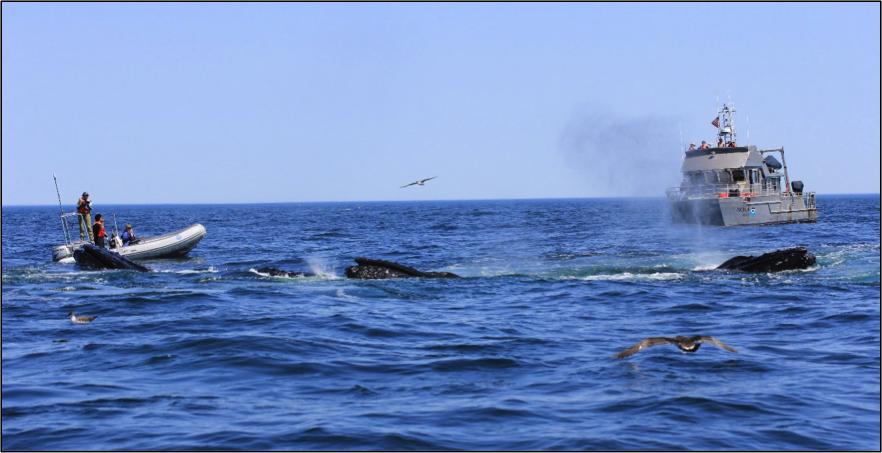Lab postdoc Dr. Tammy Silva has been hard at work in the field this summer conducting sand lance surveys, tagging and tracking shearwaters, and more! Here, Tammy shares her experiences with last month’s whale tagging expedition.
(Tammy Silva, July 10, 2019)
Two weeks ago, the research team from Stellwagen Bank National Marine Sanctuary (SBNMS) assembled on Cape Cod with some of the best whale researchers in the world to complete our 17th whale tagging expedition. SBNMS has been tagging whales since 2004, making this one of the longest and near continuous whale tagging projects in the world. The main goal of this project is to collect fine-scale movement data to help us understand the underwater behavior of whales including how they use the water column. This information is crucial for developing strategies to reduce risk of entanglement and ship-strike, the 2 leading causes of death for large whales.
To collect these data, we used 2 types sound and movement tags: DTAGs (https://www.soundtags.org/dtags/) and CATS (https://www.soundtags.org/dtags/).
DTAGs are equipped with hydrophones to record sounds produced by and heard by the tagged whale, as well as high-resolution motion sensors to measure depth, pitch, roll and heading of the tagged animal. CATS have most of the sensors above, plus high-quality video cameras. These state-of-the-art tags give us a glimpse of what these animals are doing underwater when we can’t see them. In addition to water column use, these tags enable us to study acoustic communication, social interactions, physiology, energetics, dive behavior, and foraging behavior of baleen whales. This work is a huge group effort! We collaborate with scientists from the Center for Coastal Studies (Provincetown), Moss Landing Marine Laboratories, National Marine Fisheries Service, Ocean Alliance, University of California Santa Cruz, University of Michigan, Stanford University, Syracuse University, and Woods Hole Oceanographic Institution.

A CATS fine-scale movement and video recording tag being placed on the humpback whale “Mystery” (Photo by J. Tackaberry; NMFS permit # 18059).
This year we were working out of Stage Harbor in Chatham, MA. Each morning we’d get up way before sunrise, transit on the sanctuary’s R/V Auk ~ 1 – 2 hours east of Chatham where we’d find 50 – 100 humpback whales feasting on sand lance. Absolutely amazing to see! And makes 3 am wake-up calls so worth it!
Once we found whales, we’d launch 2 RHIBS: the tagging vessel, Balena, and the focal follow vessel, LuNa. The Balena would approach and tag whales (all work conducted under NMFS permit #18059). Once a tag was on, the LuNa would stick with the tagged animal (also called a focal follow) to conduct behavioral sequencing, or writing down everything the tagged animal does. Having behavioral observations at the surface helps provide some context to what we see on the tag record and combined with the underwater tag data, provides a more complete picture of the whale’s behavior.

The R/V Auk and focal follow vessel LuNa with a group of feeding humpbacks. (Photo by J. Tackaberry; NMFS permit # 18059).
Highlights of this year’s cruise included:
- 28 humpback whales tagged,
- Many 24+ hour deployments on humpbacks (great for learning about differences in day/night behavior),
- 2 fin whales tagged,
- Longest tag deployment on a fin whale on the east coast of the US (+5 hours).
We even received an “official” award from Fay Lab PhD candidate Robert Wildermuth!
This year’s cruise was a huge success and we already can’t wait for next year! Thanks to the Volgenau Foundation, International Fund for Animal Welfare, National Marine Sanctuary Foundation, and SBNMS for continued funding and support.



